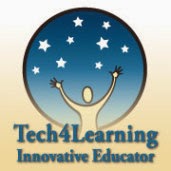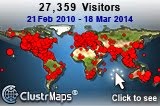I have so many posts in draft; most might never be published...but, who knows? I started writing this one last summer. I had the idea to create a classroom design challenge, based on thinking about the kinds of spaces that might be optimal for learning. Now, I have a more urgent reason to revisit these thoughts, as...(drumroll please) I am, after many, many years of being a non-classroom educator, going to be teaching 4th/5th grade language arts (and piloting 1:1 iPads with my students)!
Just before this opportunity presented itself, discussions about classroom design had been coming up in my coaching meetings with 4th/5th grade math/social studies teacher, Shelly Zavon. I encouraged her to begin the year with a blank slate, a room that would be co-created with students.
 |
| "White Wall" http://www.flickr.com/photos/93702978@N00/313983053 |
What's the Theme?
So....now is my chance to put my own ideas into action! It was funny and surprising to me that, once the students learned that I would be their teacher, many of them asked me about the "theme" of the room. I had no idea this was of such interest to them! I got some strange looks when I explained that the theme would be "learning" (as opposed to bears or turtles or outer space...), and that we would be creating the classroom space together. [This is another example to me of my differentness as a teacher. Judging by Pinterest, Teachers Pay Teachers, and the abundance of whimsical teacher blogs, I am led to believe that most elementary school teachers are super-duper organized, colorful and cutesy. I am none of these things.]
My Vision
I envision sort of a Starbucks feel (without the coffee)-- comfortable, with long tables and soft, cozy chairs. I'd love to find a couch. I have requested to have the desks removed and replaced with tables. I like plants; they add life and color to a space. The room is fairly small, so I am hoping to get rid of any furniture that is unnecessary or extra. A language arts classroom should be filled with books. As for the walls, they will be almost completely blank (with a few exceptions- more on this later) until the students begin to create (at which time they will be covered with words, thoughts, ideas and documentation of learning that is happening within them). I've begun collecting visual ideas on a "classroom design" Pinterest board.
All the Cool Kids Are Doing It
Top Private Schools Adopt a Homeschool Model lists ways in which the innovative Avenues School more closely resembles an informal home school environment than the traditional classroom with rows of desks and a teacher at the front of the room. The Avenues School seems pretty awesome.
Despite the fact that I am not a cutesy teacher, I am a very visual person and a huge believer in the importance of design. When I created my first teaching portfolio, over 20 years ago, I wrote:
"One of the most important tasks of the teacher is to set up a physical environment which is comfortable and which encourages students to interact with each other and with their surroundings. "I still believe this as wholeheartedly as when I first wrote it.
The Challenge
Below is the post I started writing last summer. I thought it would be good to engage in some thoughtful reflection about designing spaces for learning.
As you are dismantling your classrooms and packing away materials in preparation for summer break, I invite you to begin envisioning how you will set-up your classroom for next school year. Now is the time to get rid of outdated materials and resources rather than putting them into storage.
Here is the challenge. Feel free to pick and choose from the ideas below.
1. Write, revise or refer to your philosophy about learning.
2. How do the design choices you make support your beliefs about how students learn?
3. Take lots of photos of your classroom and post them- before, during and after.
4. Try to look at your classroom through the eyes of a child. What does the child see? Is it inviting? Over-stimulating? Comfortable?
5. Now look through the eyes of a parent. When a parent looks into your room for the first time, are they excited for their child? Is the room well-organized? Alive? Does it look like a place for exciting learning?
6. Look at the walls and use this rubric (from our school's learning target) to self-assess and set goals.
[Note: I really like this focus on classroom walls. It's easy to see where you are and easy to move forward. It's a concrete, external change that can also change the way that students are co-creators in the learning environment. So many teachers use pre-made posters with information about math or language arts, but do students actually use the information? Do they know in what situation it might be useful? Are they more likely to access the chart that they, themselves, helped to create?
 |
| Image: Angela Stockman |
What else? What are your ideas for adding to the list of challenge activities?




.jpeg)
.jpeg)
.jpeg)
.jpeg)








